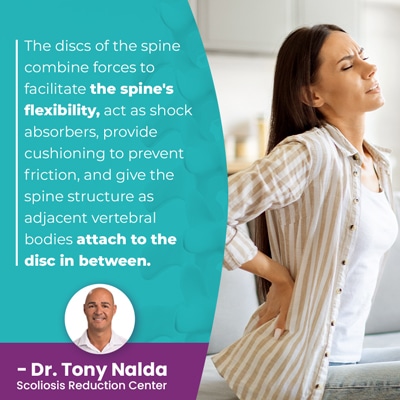Herniated Disc Surgery: What to Expect and Recovery Tips

When the spine starts to degenerate, it often starts in the discs. Intervertebral discs play many key roles in maintaining spinal health and function. Disc health is important to maintain because as the discs don't have their own vascular supply, repair is difficult.
When a disc herniates, its inner nucleus has pushed through a tear in its outer annulus, and this means the disc's inner material is projecting into the spine, taking up extra space. Depending on severity, a discectomy can be necessary.
Before getting to the specifics of disc surgery, let's explore the connection between disc health and overall spinal health.
Table of Contents
A Healthy Spine
Just as the discs are important for overall spinal health, the spine is key to the body's overall health. The spine allows us to stand upright and practice good posture, protects important organs, and works with the brain to form the central nervous system.
The central nervous system is a vast communication system that allows the brain to communicate with the rest of the body.
A healthy spine will have its natural curves in place, making it stronger, more flexible, and better able to handle mechanical stress.
A healthy spine will be strong and flexible.
A healthy spine will have hydrated discs that maintain their central position between adjacent vertebrae; the spine consists of vertebrae (bones of the spine) stacked on top of one another, and the discs that sit between them perform a number of functions.
Why Are the Spinal Discs so Important?
 The discs of the spine combine forces to facilitate the spine's flexibility, act as shock absorbers, provide cushioning to prevent friction, and give the spine structure as adjacent vertebral bodies attach to the disc in between.
The discs of the spine combine forces to facilitate the spine's flexibility, act as shock absorbers, provide cushioning to prevent friction, and give the spine structure as adjacent vertebral bodies attach to the disc in between.
When we're born, the discs are largely made of water, but as we age, they can lose fluid and become dehydrated, and this type of degeneration can change a disc's shape and cause uneven wear and tear.
As adjacent vertebrae attach to the disc in between, a change in disc health and/or shape can also affect the position of the vertebrae and affect the spine's curves; if the spine loses a healthy curve, a number of problems can develop.
Disc Herniation
Discs consist of two main structures: a soft gel-like inner nucleus and a tough durable outer layer known as the annulus.
If a disc's inner nucleus pushes through a tear in its outer annulus, this is disc herniation, and it can be problematic because the disc's inner material is now taking up extra space within the spine, and this can often mean compressing the herniated disc's surroundings, which can include the spine and its surrounding tissues, muscles, and nerves.
If a nerve is being compressed, it's being exposed to uneven pressure and can cause a number of symptoms; to improve symptoms, pressure on the affected nerve(s) has to be relieved.
Herniated Disc Symptoms
Where in the spine the disc is located will shape a patient's symptoms. There are three main sections of the spine: the cervical spine (neck), thoracic spine (middle/upper back), and the lumbar spine (lower back).
The most common symptom of a herniated disc is back pain, and this can involve pain in the area and/or radiating pain due to compressed nerves.
Herniated discs can develop anywhere in the spine, but they are the most common in the lower back because of the role the lumbar spine plays in overall spinal health and function; the lumbar spine has to support the weight of the trunk, the spinal sections above, and its vertebrae and discs feel the effects of strenuous movement and activities.
For example, a common complication of disc herniation in the lumbar spine is sciatic nerve pain; the sciatic nerve starts in the lower back, so if a disc herniates in the lumbar spine, it can press on the sciatic nerve, causing nerve compression and pain that radiates along the nerve's pathway throughout the lower body.
Nerve pain can range from mild to severe and is described as sharp, burning, or aching. Radiating pain usually extends into the extremities where sensations of numbness and/or tingling are also common.
Muscle weakness can develop, as can a loss in balance and reflexes.
The more severe a patient's herniated disc symptoms are, the more likely it is that a surgical recommendation will be made.
What is Herniated Disc Surgery?
There are different ways to respond to a herniated disc from nonsurgical treatment to disc surgery for severe cases.
 Herniated disc surgery commonly is a type of discectomy: a surgical procedure that removes the damaged portion of the disc that's compressing nearby nerves.
Herniated disc surgery commonly is a type of discectomy: a surgical procedure that removes the damaged portion of the disc that's compressing nearby nerves.
An open discectomy involves a larger incision, and a microdiscectomy involves a smaller incision made with a microscope.
In some instances, a laminotomy/laminectomy is performed; this involves the removal of a small portion of bone covering the affected nerve. The bone removal means more space for the nerve to function within and makes it easier to access the herniated disc.
Artificial disc surgery is performed on a single disc commonly located in the lumbar spine (lower back) and involves the surgeon making an incision in the abdomen, through which the damaged disc is replaced with a disc made of metal and plastic.
Recovery time in hospital for artificial disc surgery is generally within a week.
Spinal fusion can also be performed for a herniated disc as it immobilizes the fused portion of the spine; this involves fusing multiple vertebrae together and attaching metal rods to the spine with pedicle screws to prevent movement.
Recovery time spent in hospital for spinal fusion is typically within two weeks, but the recovery period extends to home with activity restrictions that typically last for two months following the procedure.
The goal of surgical procedures for disc herniation is to relieve pressure on a compressed nerve to prevent nerve damage and improve symptoms.
Recovery Time and Tips
No two patients will respond to surgical treatment in the exact same way; there are a number of factors that shape patient-response including age and overall health, weight, location of the discectomy, how many discs are involved, type of surgery, and whether or not there were any complications during the procedure.
Recovery time can range between several weeks and several months, and just like all surgical treatment, there are risks involved. Specific recovery time estimates can be provided by a patient's surgeon.
Potential complications of herniated disc surgery can include nerve damage, infection, and excessive blood loss.
The most important recovery tip is to follow instructions by the surgeon and care team, in addition to a lot of rest, gentle movement, avoiding strenuous activities, monitoring the surgical site, staying hydrated, and following any physical therapy recommendations.
Nonsurgical Treatment for Disc Herniation
It's also important for those suffering from disc herniation to understand that not all herniated discs require surgical treatment.
Particularly when diagnosed early and treated proactively, a herniated disc can respond well to conservative treatment.
One of the challenges to maintaining disc health over time is that the discs don't have their own vascular supply, making it difficult to recover and heal from injury and/or degenerative changes.
A key facet of treatment for a number of disc issues, including herniation, involves physical therapy and condition-specific exercise recommendations to increase circulation and blood flow around the affected disc.
Also, strengthening the spine's surrounding muscles means less pressure on the spine and its individual structures and parts, including the spinal discs and surrounding nerves.
Chiropractic care can also be applied to address any areas of vertebral subluxation that could be contributing to the affected disc's health and take pressure off an affected disc and nerve.
Rest and lifestyle guidance can also help, as can a number of therapies and medications.
Conclusion
Herniated disc surgery comes with risks, as any surgical procedures do, and the different types can include discectomy, artificial disc surgery, and spinal fusion.
When a disc herniates, its inner material has pushed through its outer layer and is compressing nearby nerve roots, and this can cause a variety of symptoms, most noticeably back pain and pain that radiates into the extremities.
We surgery can be necessary in some cases, not all cases need surgical intervention, with conservative treatment options also offering impressive results.
Here at the Scoliosis Reduction Center®, treatment options are proactive and nonsurgical because that's what compliments the spine's natural movement-based design.
Through chiropractic care and physical therapy, pressure can be taken off the affected disc and nearby nerves, circulation can be improved so the disc can absorb important nutrients needed for repair, and the spine's surrounding muscles can be strengthened for more spinal support and stability.
Dr. Tony Nalda
DOCTOR OF CHIROPRACTIC
After receiving an undergraduate degree in psychology and his Doctorate of Chiropractic from Life University, Dr. Nalda settled in Celebration, Florida and proceeded to build one of Central Florida’s most successful chiropractic clinics.
His experience with patients suffering from scoliosis, and the confusion and frustration they faced, led him to seek a specialty in scoliosis care. In 2006 he completed his Intensive Care Certification from CLEAR Institute, a leading scoliosis educational and certification center.
About Dr. Tony Nalda
 Ready to explore scoliosis treatment? Contact Us Now
Ready to explore scoliosis treatment? Contact Us Now





